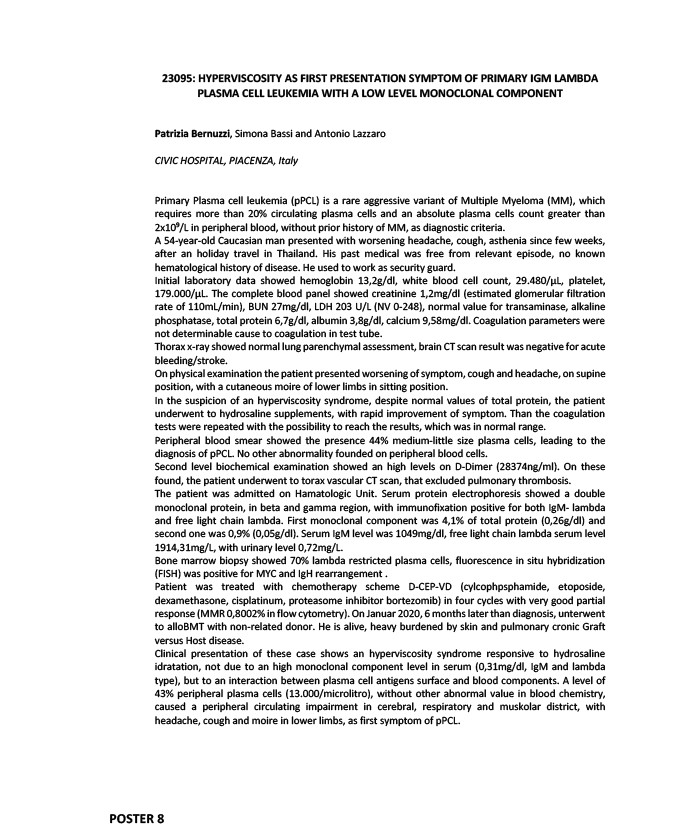
23095: HYPERVISCOSITY AS FIRST PRESENTATION SYMPTOM OF PRIMARY IGM LAMBDA
POSTER 8
PLASMA CELL LEUKEMIA WITH A LOW LEVEL MONOCLONAL COMPONENT
Patrizia Bernuzzi, Simona Bassi and Antonio Lazzaro
CIVIC HOSPITAL, PIACENZA, Italy
Primary Plasma cell leukemia (pPCL) is a rare aggressive variant of Multiple Myeloma (MM), which
requires more than 20% circulating plasma cells and an absolute plasma cells count greater than
2x109/L in peripheral blood, without prior history of MM, as diagnostic criteria.
A 54-year-old Caucasian man presented with worsening headache, cough, asthenia since few weeks,
after an holiday travel in Thailand. His past medical was free from relevant episode, no known
hematological history of disease. He used to work as security guard.
Initial laboratory data showed hemoglobin 13,2g/dl, white blood cell count, 29.480/μL, platelet,
179.000/μL. The complete blood panel showed creatinine 1,2mg/dl (estimated glomerular filtration
rate of 110mL/min), BUN 27mg/dl, LDH 203 U/L (NV 0-248), normal value for transaminase, alkaline
phosphatase, total protein 6,7g/dl, albumin 3,8g/dl, calcium 9,58mg/dl. Coagulation parameters were
not determinable cause to coagulation in test tube.
Thorax x-ray showed normal lung parenchymal assessment, brain CT scan result was negative for acute
bleeding/stroke.
On physical examination the patient presented worsening of symptom, cough and headache, on supine
position, with a cutaneous moire of lower limbs in sitting position.
In the suspicion of an hyperviscosity syndrome, despite normal values of total protein, the patient
underwent to hydrosaline supplements, with rapid improvement of symptom. Than the coagulation
tests were repeated with the possibility to reach the results, which was in normal range.
Peripheral blood smear showed the presence 44% medium-little size plasma cells, leading to the
diagnosis of pPCL. No other abnormality founded on peripheral blood cells.
Second level biochemical examination showed an high levels on D-Dimer (28374ng/ml). On these
found, the patient underwent to torax vascular CT scan, that excluded pulmonary thrombosis.
The patient was admitted on Hamatologic Unit. Serum protein electrophoresis showed a double
monoclonal protein, in beta and gamma region, with immunofixation positive for both IgM- lambda
and free light chain lambda. First monoclonal component was 4,1% of total protein (0,26g/dl) and
second one was 0,9% (0,05g/dl). Serum IgM level was 1049mg/dl, free light chain lambda serum level
1914,31mg/L, with urinary level 0,72mg/L.
Bone marrow biopsy showed 70% lambda restricted plasma cells, fluorescence in situ hybridization
(FISH) was positive for MYC and IgH rearrangement .
Patient was treated with chemotherapy scheme D-CEP-VD (cylcophpsphamide, etoposide,
dexamethasone, cisplatinum, proteasome inhibitor bortezomib) in four cycles with very good partial
response (MMR 0,8002% in flow cytometry). On Januar 2020, 6 months later than diagnosis, unterwent
to alloBMT with non-related donor. He is alive, heavy burdened by skin and pulmonary cronic Graft
versus Host disease.
Clinical presentation of these case shows an hyperviscosity syndrome responsive to hydrosaline
idratation, not due to an high monoclonal component level in serum (0,31mg/dl, IgM and lambda
type), but to an interaction between plasma cell antigens surface and blood components. A level of
43% peripheral plasma cells (13.000/microlitro), without other abnormal value in blood chemistry,
caused a peripheral circulating impairment in cerebral, respiratory and muskolar district, with
headache, cough and moire in lower limbs, as first symptom of pPCL.